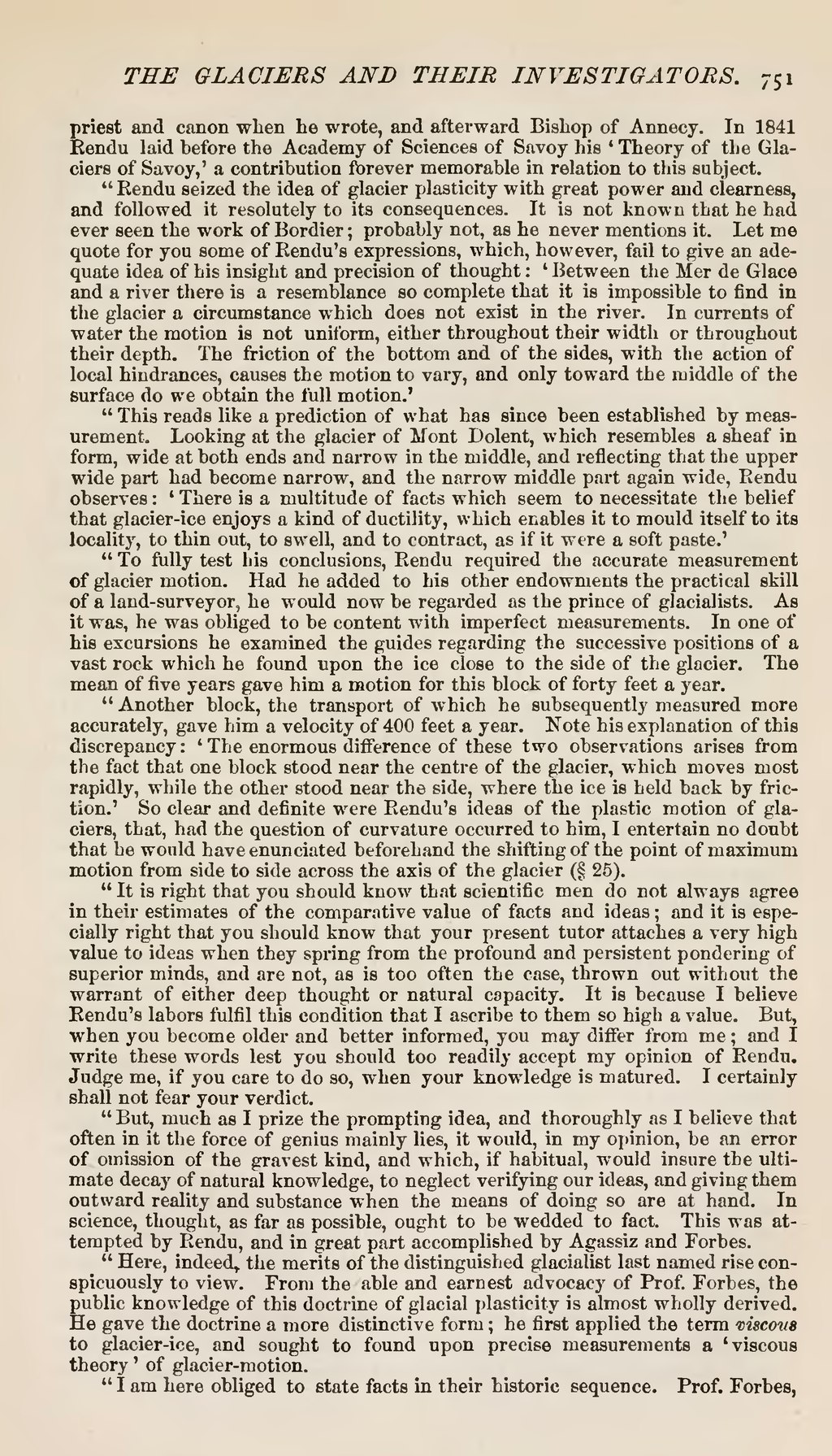priest and canon when he wrote, and afterward Bishop of Annecy. In 1841 Rendu laid before the Academy of Sciences of Savoy his 'Theory of the Glaciers of Savoy,' a contribution forever memorable in relation to this subject.
"Rendu seized the idea of glacier plasticity with great power and clearness, and followed it resolutely to its consequences. It is not known that he bad ever seen the work of Bordier; probably not, as he never mentions it. Let me quote for you some of Rendu's expressions, which, however, fail to give an adequate idea of his insight and precision of thought: 'Between the Mer de Glace and a river there is a resemblance so complete that it is impossible to find in the glacier a circumstance which does not exist in the river. In currents of water the motion is not uniform, either throughout their width or throughout their depth. The friction of the bottom and of the sides, with the action of local hindrances, causes the motion to vary, and only toward the middle of the surface do we obtain the full motion.'
"This reads like a prediction of what has since been established by measurement. Looking at the glacier of Mont Dolent, which resembles a sheaf in form, wide at both ends and narrow in the middle, and reflecting that the upper wide part had become narrow, and the narrow middle part again wide, Rendu observes: 'There is a multitude of facts which seem to necessitate the belief that glacier-ice enjoys a kind of ductility, which enables it to mould itself to its locality, to thin out, to swell, and to contract, as if it were a soft paste.'
"To fully test his conclusions, Rendu required the accurate measurement of glacier motion. Had he added to his other endowments the practical skill of a land-surveyor, he would now be regarded as the prince of glacialists. As it was, he was obliged to be content with imperfect measurements. In one of his excursions he examined the guides regarding the successive positions of a vast rock which he found upon the ice close to the side of the glacier. The mean of five years gave him a motion for this block of forty feet a year.
"Another block, the transport of which he subsequently measured more accurately, gave him a velocity of 400 feet a year. Note his explanation of this discrepancy: 'The enormous difference of these two observations arises from the fact that one block stood near the centre of the glacier, which moves most rapidly, while the other stood near the side, where the ice is held back by friction.' So clear and definite were Rendu's ideas of the plastic motion of glaciers, that, had the question of curvature occurred to him, I entertain no doubt that be would have enunciated beforehand the shifting of the point of maximum motion from side to side across the axis of the glacier (§25).
"It is right that you should know that scientific men do not always agree in their estimates of the comparative value of facts and ideas; and it is especially right that you should know that your present tutor attaches a very high value to ideas when they spring from the profound and persistent pondering of superior minds, and are not, as is too often the case, thrown out without the warrant of either deep thought or natural capacity. It is because I believe Rendu's labors fulfil this condition that I ascribe to them so high a value. But, when you become older and better informed, you may differ from me; and I write these words lest you should too readily accept my opinion of Rendu. Judge me, if you care to do so, when your knowledge is matured. I certainly shall not fear your verdict.
"But, much as I prize the prompting idea, and thoroughly as I believe that often in it the force of genius mainly lies, it would, in my opinion, be an error of omission of the gravest kind, and which, if habitual, would insure the ultimate decay of natural knowledge, to neglect verifying our ideas, and giving them outward reality and substance when the means of doing so are at hand. In science, thought, as far as possible, ought to be wedded to fact. This was attempted by Rendu, and in great part accomplished by Agassiz and Forbes.
"Here, indeed, the merits of the distinguished glacialist last named rise conspicuously to view. From the able and earnest advocacy of Prof. Forbes, the public knowledge of this doctrine of glacial plasticity is almost wholly derived. He gave the doctrine a more distinctive form; he first applied the term viscous to glacier-ice, and sought to found upon precise measurements a 'viscous theory' of glacier-motion.
"I am here obliged to state facts in their historic sequence. Prof. Forbes,